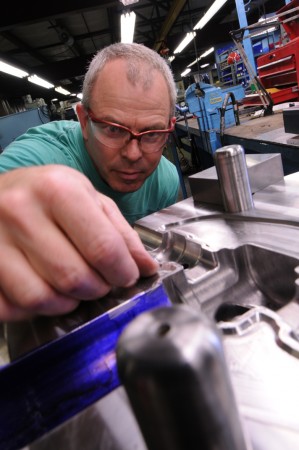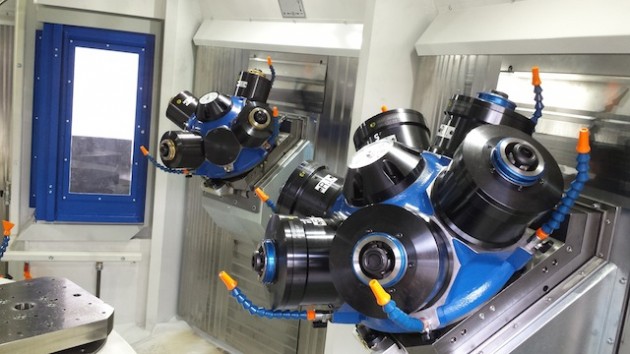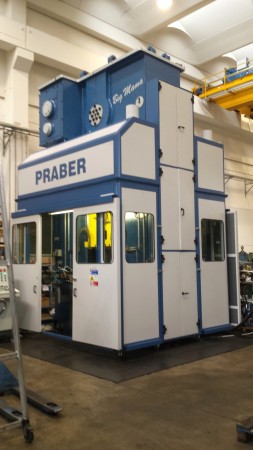
Lofthouse Manufacturing thrives through investment in innovation
by Brandi Cowan

A commitment to cutting-edge technology keeps Ontario forging and machining company in growth mode

Located in an area with a small labour pool, Lofthouse augments production with robotic technology. —Photos courtesy of Lofthouse Manufacturing
Burk’s Falls is one of Ontario’s smaller towns, with a population of less than 1,000. But one of its manufacturers—Lofthouse Manufacturing—is quickly becoming a heavyweight in Canada’s forging and machining sector.
A big part of its success is a willingness to invest in technology and innovation; to the tune of more than $18 million in state-of-the-art automated equipment and production systems over the past five years.
The original company, which was founded in 1957 by George Lofthouse, offers nonferrous forging and machining, primarily of brass and aluminum products, for clients in a variety of sectors including the automotive, electrical, plumbing and recreational vehicle markets.
“Our differentiating factor is complex, moderate to high-volume products, and we’re one of very few high end forging companies in nonferrous metals in North America,” says Doug Driscoll, sales manager for Lofthouse.
“We’re a parts manufacturer, but we do a lot of front-end engineering with our customers to help them design a cost-effective and functional component right at the beginning of the project.”
To meet customer demand for these complex parts, Lofthouse regularly invests in machinery to help the company produce to the exacting standards demanded by clients.
One of its transfer machines, referred to in-house as “The Monster,” features 41 drilling, tapping and machining units, which gives Lofthouse tremendous flexibility to perform many complex operations on a part using a single machine.
View a video of one of Lofthouse’s transfer machines
“Having this machine has allowed us to take on a high-volume part from one of our largest customers which in the past, we simply couldn’t have taken on. It also makes other parts that we have some difficulty with much easier to produce,” explains Derek Dobbs, engineering manager with Lofthouse.
At the moment there are only two of these machines in operation worldwide. One is housed at Lofthouse in Burk’s Falls, and the other is operated by Lofthouse’s parent company, Brawo Brassworking S.p.A. in Italy.

The Vertiflex 450 transfer machine offers the largest machining envelope available for the manufacture of larger, more complex parts, beyond what the company could previously produce.
Lofthouse also purchased a Vertiflex 450 transfer machine, recognizing the value it could add to the company’s operations. The Vertiflex offers the largest machining envelope available so it’s well suited to the manufacture of larger, more complex parts—beyond what the company was previously able to produce with existing machinery.
The company owns an Italian-made 550 auto-forge press as well. The Praber Press machine is the only one of its kind in North America.
Lofthouse’s forging department will soon be getting even more impressive new equipment. “We’re investing in a new automatic graphitizing machine that automatically applies the right amount of graphite to coat the billets before they go into the auto-forges,” Dobbs says.
To accommodate its increasing capabilities and growing equipment inventory, Lofthouse broke ground on an expansion this year. The addition will add an extra 48,000 square feet of space to the company’s manufacturing footprint, nearly doubling the 50,000 square feet its manufacturing plant currently occupies.
“It’s going to allow us to be more efficient,” Driscoll says. “Right now, because we are so busy, there are a lot of housekeeping challenges in moving product around, work-in-process, and so on. The expansion is going to give us a little bit more inventory space.”
It will also enable the company to perform upgrades to the existing shop space, which haven’t been possible so far due to space constraints.
With office and administration space factored in, Lofthouse’s footprint will total approximately 118,000 square feet once construction is completed.
A data driven operation
Lofthouse’s entire shop floor is integrated with its STAIN software system. Developed by Brawo Brassworking and rolled out at Lofthouse in 2009, STAIN is an enormous database that collects real-time data from the shop floor and stores it for future retrieval and analysis.
“At any moment in time, management can look at the STAIN system and tell which machines are running, and if they are running to the standard rate. STAIN also reports on machine downtime and overall productivity rates. “You can go back as far as you want to find out what the history of the downtime is for that machine,” Dobbs explains.
Having this historical information at their fingertips allows managers to be proactive about machine maintenance, replacing a part as it nears the predicted end of its lifespan, rather than waiting for it to break down and disrupt production before swapping in a replacement part.
The software also integrates the engineering department with the technical side of the shop. Engineering can create drawings and tool codes, set up sheets and process layouts, documenting everything by machine and part number.
That information can then be communicated to the Remstar vertical storage and retrieval system, where several elevators store and retrieve all of the equipment needed by the tooling department.
The tool crib will select all the necessary tools automatically, set them up in the holders according to the instructions entered into the STAIN software, and then present the tools for the workers responsible for setting up the machines.
“Set-up time is minimized, theoretically. If everything is done according to STAIN, the part will come out of the machine in a very efficient manner,” Dobbs says.
The STAIN system has had a marked impact on efficiency, and has become an important tool in Lofthouse’s performance management toolbox for frontline personnel.
“It’s now part of the performance review: we take a look at what their actual versus standard rates are, what their global productivity is when they’re running a machine, and that data becomes part of the goal-setting process,” says Wendy Stroud, human resources manager with Lofthouse.
Maintaining a talent pipeline
With the expansion now well underway, Lofthouse must do more than simply maintain its current staffing levels.
Stroud anticipates the company will be looking to expand its current headcount of approximately 170, including six apprentices, by about 10 per cent once the additional shop space is operational.
With the largest segment of Lofthouse’s workforce occupying the 40 to 50 age demographic, Stroud says succession planning plays an important part in the company’s talent management strategy.
“We’re really focusing on things like cross-training and making sure that there’s not just one person who knows what’s going on in a department. We’re trying to diversify our staff group as much as possible so that we are planning for the future appropriately.”
Lofthouse is also constantly on the look out for young talent who can contribute to the company’s success now and in the future.
“We have a very good relationship with Canadore College, out of North Bay,” Dobbs says. Each year students are welcomed for a tour of Lofthouse’s facilities, giving them a taste of what their future careers could hold.
To address the staffing challenges posed by operating in Northern Ontario, outside of the province’s manufacturing heartland, Lofthouse makes a point of offering a competitive rewards package.
The company also strives to be flexible and accommodating so staff with longer commutes are able to balance personal commitments with their scheduled shifts.
“The downside of being in a remote area is a small pool to draw from a direct labour stand point. To overcome that, our push is to implement as much robotic technology as possible to help fill those gaps,” Dobbs says.
“That’s not to say we’re using robots to push out people; we’re using robots to complement the people that we have here.”
With a shop that operates 24 hours per day, seven days per week, 362 days per year, striking the right balance of talented people and cutting edge machinery will be key to Lofthouse’s future success.
Brandi Cowan is an editor with Annex Business Media in Toronto.
This article is part of the Industrial Edge Showcase, sponsored by Machines Italia, a project of the Italian Trade Commission.
